The Duel in Irish History by James Kelly
Published in 18th-19th Century Social Perspectives, 18th–19th - Century History, Features, Issue 1 (Spring 1994), Volume 2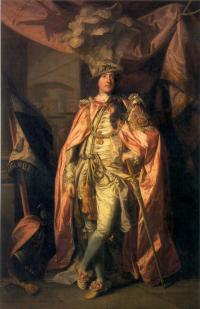
The Earl of Bellamont
(COURTESY OF THE NATIONAL GALLERY OF IRELAND)
On 2 February 1773, four peers – Lord Townshend, the Earl of Bel/amont and their seconds Lords Ancram and Ligonier – assembled in Marylebone Fields on the outskirts of London to determine an affair of honour.
The dispute arose from an injury Townshend was deemed to have done Bellamont the previous year when he was Lord Lieutenant of Ireland. It was most unusual to offer a challenge to a former lord lieutenant for something he had done while in office, but Bellamont was an unusual man. An unstable individual, his vile temper and poor judgement had got him into numerous scrapes. He now felt that an exchange of shots was the only way he could cleanse his reputation of the stain it had incurred in January 1772 when Townshend had sent a mere minor official to inform the waiting peer that he was unable to receive him at Dublin Castle to discuss a patronage matter. Bellamont perceived a deliberate insult. When Townshend retired from office, he initiated the proceedings which resulted in Townshend, Bellamont and their seconds assembling for a duel.
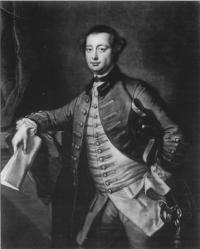
Lord Townshend.
(COURTESY OF THE NATIONAL GALLERY OF IRELAND)
fired. Only Townshend’s found its target,hitting Bellamont in the groin and so incapacitating him that he had to be carried from the field in a chair. Given their eminence, it was entirely predictable that the TownshendBellamont encounter should cause a sensation. Reports of the duel were carried in all the newspapers of the day, and such was the level of public hostility towards Townshend in Ireland that the irascible Bellamont was soon being hailed as a hero. Critics of the former lord lieutenant applauded Bellamonfs courageous stand as the action of a man of principle. This was straining the truth, but bravery on the duelling field was highly prized among devotees of the code of honour in Ireland, which included most of the Protestant social and political elite. Indeed, the favourable publicity accorded duelling as a consequence of this encounter boosted its popularity and the number of encounters that took place in Ireland in the 1770s and 1780s reached an all-time high. The Townshend-Bellamont was not the only duel that contributed to this efflorescence, but it was the most widely publicised because of the involvement of a former lord lieutenant. A number of previous lords lieutenant had been threatened with challenges as a result of actions taken by them while in office, but none had proceeded to an exchange of shots. Indeed, government circles believed that it was wrong to compel a man to risk his life in defence of his honour because of a position he had taken on an official rather than a personal matter; officials were concerned lest the TownshendBellamont encounter set an accordingly dangerous precedent.
Code of honour
As this event and several hundred other examples bear witness, honour was a matter of vital import to anyone who believed himself a gentleman in early modern Ireland. Though seldom discussed as other than a theoretical abstraction, honour possessed a tenacious hold on the minds and lives of gentleman in Ireland between the mid-seventeenth and the mid-nineteenth centuries when duelling flourished. In effect, it provided each individual with a code of behaviour by which he should live, because ostracism from the elite was the penalty for being perceived to be without honour or to have brought dishonour upon oneself and, by implication and extension, upon the privileged class to which one belonged or aspired to belong. It is for this reason that so few challenges were declined. Only an individual of exceptional resolution refused a challenge, even if convinced that it was unwarranted, because it could be interpreted as the action of a coward rather than of a man of principle. This is well illustrated by the decision of John Beresford, an aristocrat of several generations’ standing whose brother was the Earl of Tyrone and who was one of the commissioners of the revenue, to exchange shots with Sir Edward Newenham in 1778 though he plainly believed that Newenham was not his social equal. As this implies, the damage that could be done to an individual’s reputation by mishandling an affair of honour was enormous. In 1792, the colourful Dublin radical James Napper Tandy was thoroughly discredited in the eyes of his radical colleagues, who purported to wish to bring the edifice of privilege tumbling down, as well as of aristocrats, when his bungling response to a belittling speech by the solicitor general in the House of Commons convinced many that he was a coward and a poltroon entirely without honour. ‘Poor Tandy’, William Drennan observed piquantly, ‘after eighteen years struggle against his own interest in the public cause, has nearly lost his reputation as a gentleman in a quarter of an hour.’
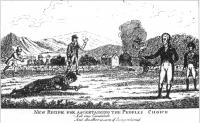
Contemporary cartoon of the duel between
John Colclough and William Alcock during
the Wexford election of 1807. Colclough
was killed and his supporters claimed that
Alcock had taken unfair advantage by
wearing large spectacles. (COURTESY OF
KEVIN WHELAN)
From Italy to Ireland
Lieutenant Bridges and Ensign Trevor Lloyd in 1670 following a difference ‘at play … at the Castle Tavern’. Slaughter was killed. and Lloyd. Bridges. Brabazon and Fitzgerald all wounded. Most duels were between representatives of the New English landed elite inserted into Ireland during the late sixteenth and seventeenth centuries. because adherence to the code of honour was one of the features of the essentially aristocratic lifestyle they sought to introduce. But duelling was also popularised by representatives of the Catholic Old English who returned to Ireland from the continent in the 1660s after having spent the preceding decade in exile with the Stuart court. Not surprisingly. given the animus that characterised relations between the two interests. encounters between Catholics and Protestants were not uncommon during the Restoration era. However. following the defeat of the Jacobite army in the early 1690s. the enlistment of most of the Jacobite soldiery in the ranks of European armies and the legal disarmament of Catholics by the Penal Laws. Catholic involvement in affairs of honour effectively concluded for a century. Most duels in the seventeenth and early eighteenth centuries were fought with swords. The casualty rate was high because a large percentage were not precise observances of the duelling ritual. For example. when the Dublin justice of the peace Adam Cusack engaged his relation Lieutenant Brice following a disagreement at dinner in December 1716. the two men simply picked up their weapons. went outside and fought to a standstill; Brice died of his wounds the next day and Cusack a few days later.
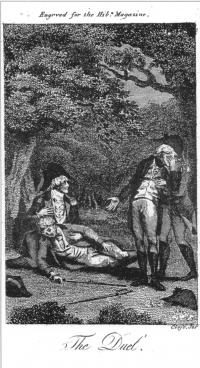 Flamboyant fire eaters
Flamboyant fire eaters
The Cion mel rules of 1777
The activities of unstable individuals like George Robert Fitzgerald served to entrench a reputation abroad that Irishmen were inveterate enthusiasts of the code of honour. This was not entirely deserved since duelling was also widely practised in Britain, France and other parts of Europe. Moreover, there were domestic critics of duelling in the law and in organisations like the Friendly Brothers of St Patrick and the Knights of Tara, and it was in response to criticism from such quarters that a number of soi disant Irish duelling experts gathered in Clonmel in 1777 to draft a set of ‘rules .. .for general adoption throughout Ireland’ in order to ensure that all duels were conducted properly. It is difficult to establish the impact of this initiative, but the increased readiness of seconds in the late eighteenth century to intervene to reconcile antagonists can be partially attributed to their efforts. One other noteworthy change took place in the final decades of the eighteenth century. An increased percentage of duels was fought in Munster. In the early and mid-eighteenth century, Dublin city was the duelling epicentre of the country, and the Phoenix Park emerged as the kingdom’s preferred killing field. The appeal of the Park lay in its size as well as its proximity to the city of Dublin. Duellists and their seconds could go there secure in the knowledge that they had an opportunity to blaze away free from interruption but within convenient access of the city should urgent medical help prove necessary. The Phoenix Park remained the country’s favoured duelling spot until the early nineteenth century, when Dublin gradually disengaged itself from those gentlemen and soldiers who insisted on defending their honour against insult with weapons, and proportionately more duels were fought in the provinces. Outside of Dublin, Munster and Leinster played host to most duels; Ulster was and remained the province least amenable to the code of honour. Though the number of duels taking place remained high for some decades thereafter, there was a visible increase in opposition to the code of honour in the late 1780s and 1790s. A number of headline cases served to illustrate that the courts would no longer turn a blind eye to those guilty of abusing the privilege of duelling. Great care must be taken not to exaggerate the impact of antiduelling sentiment, however. There was a palpable invigoration of antiduelling opinion in the last fifteen years of the eighteenth century and the first decade of the nineteenth, but it remained visibly weaker than the conviction that a man’s honour could only be cleansed of the stain of insult by recourse to weapons. This is particularly well illustrated by the inability of political radicals to decline offering or accepting challenges. Thomas Russell, for example, dismissed duelling as a ‘shameful vice of the rich’, but he still felt it was his ‘duty’ to fight when he was involved in an ugly incident with Lord Cole at Enniskillen in 1793.
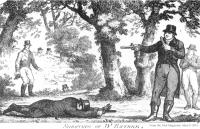 The O’Connell-D’Esterre duel
The O’Connell-D’Esterre duel
The demise of duelling
O’Connell’s decision not to offer or to accept any challenges mirrored the rising level of opposition to the code of honour. More and more people in the 1820s and 1830s concurred with the young W.E. Gladstone that duelling was ‘barbarous, inhuman and unchristian’ and urged the authorities to take decisive measures to abolish it. Such calls multiplied as a consequence of the ‘great moral change’ taking place in Irish society at this moment, which prompted a number of evangelically-minded Protestants to establish a short-lived ‘Association for the Suppression of Duelling’ in 1830. This organisation did not emulate the high hopes of its founders, but the widespread revulsion following the controversial death of Standish Stamer O’Grady in Dublin in 1830 hastened the demise of duelling in the capital. It continued to be practised for a time thereafter in Munster and Connacht, but the opposition of the Royal Irish Constabulary made it increasingly difficult for intending duellists to meet free from the threat of interruption. Only the most determined protagonists were prepared openly to defy the law, and by the mid 1840s most differences were settled without an exchange of shots. The demise of duelling in the midnineteenth century was a triumph for the rule of law over that of traditional noble privilege, and for middle class over aristocratic values. These contrarytendencies had been locked in a struggle for pre-eminence in Ireland since at least the late eighteenth century. The code of honour flourished for a number of decades despite this, but it never again reached the peak of popularity and respectability it enjoyed in the 1770s and 1780s. In the nineteenth century, the aristocratic milieu in which it operated gradually gave way to a world dominated by middle class values. This placed greater emphasis on lawful and proper behaviour and demanded successfully that the state appropriate the responsibility of arbitrating between individuals in dispute, irrespective of their social status.
James Kelly lectures in history at St. Patrick’s College, Drumcondra.
















